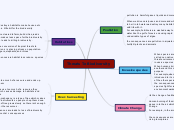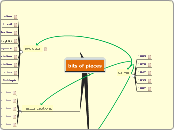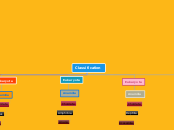Unit 1: Diversity of Living things
Classifying Life
Dichotomous Keys
- Used to classify living things by their traits
- Use constant characteristics rather than variable ones. (e.g. Flowers change with the seasons)
- Use measurements rather than terms like "large" and "small".
Characteristics of Living things:
All living organisms:
- Are composed of cells
- Have different levels of organization
- Use energy for growth and maintenance
- Respond to their environment
- Grow
- Reproduce
- Adapt to their environment
Viruses
Lytic Cycle
#1: Attachment: Virus attaches to host cell
#2: Insertion: Virus inserts DNA into nucleus of host cell
#3: Replication: Destroys cell’s DNA, forced to create Virus DNA
#4: Assembly: New viruses are created inside the host cell
#5: Lysis: Cell breaks open, releasing new viruses
Lysis: disintegration of a cell by rupture of a cell wall or membrane
Lysogenic Cycle:
#1: Virus attaches to cell (attachment)
#2: Virus DNA enters cell (insertion)
#3: Virus DNA incorporates into cell DNA
#4: Cells keep replicating until triggered out of the lysogenic cycle
Triggered by change in temperature, immunity, hormones and more.
Non-living entity that carries genetic material.
- Are not made of cells
- Cannot gather energy
- Cannot grow
Binomial nomenclature: writing species names
- The first name is the Genus name → This is capitalized
- The second name is the species name → this is NOT capitalized
- The entire name must be EITHER typed in italics OR underlined if written by hand
Taxonomy – the science of identifying and classifying living things
Taxonomy groups species using shared characteristics, getting more specific as you go down a level: Domain, Kingdom, Phylum, Class, Order, Family, Genus, Species
Species concepts
Phylogenetic: Defines species based on shared common ancestors or shared evolutionary history
Morphological: What traits does it share with organisms?
Biological: Can two organisms interbreed in nature and create fertile offspring?
Ex: Breeding a horse and a donkey fails this test
Prokaryotic vs Eukaryotic
Bacteria reproduction
Conjugation: Transfer of genetic material, no new cell is created, similar to sexual reproduction
#1: Donor cell attaches to recipient cell by attaching a pilus to a receptor site
#2: Plasmid of donor cell is replicated
#3: Strand of plasmid (sometimes the entire plasmid) is cut from the donor cell and enters recipient cell
#4: Cells separate. Recipient cell replicates new plasmid and becomes a donor cell
Increases genetic diversity, slower process, no new cells are made
Antibiotics
Inhibits certain functions of a cell to help eliminate them. For example:
- Prevent cell wall from forming
- Prevent DNA synthesis
- Prevent folate synthesis
- Prevent protein synthesis
Antibiotic resistance
Through mutation and conjugation, bacteria can evolve traits to become resistant to antibiotics. This is problematic as is renders existing medicine ineffective.
Some causes are:
- Overuse of antibiotics, using antibiotics when not needed
- Misuse of antibiotics ; for example, not taking enough antibiotics to completely eliminate all bacteria present in the body, even if no longer feeling ill
- Antibiotics in the food industry: Antibiotics given to animals can pass into our food, causing bacteria in our bodies to gain resistance.
Binary fission: form of asexual reproduction
#1: DNA (and plasmid if available) is duplicated
#2: cell elongates
#3: cell splits into two identical cells
Very rapid, low genetic diversity
Eukaryotic cells are much larger than prokaryotic cells because eukaryotic cells tend to be more efficient and organized at using available resources. This allows them to grow larger.
Eukaryotic cells evolved into existence much later than prokaryotic cells
Endosymbiosis: Engulfing different organisms (not digest) to work together.
Host cell engulfs the endosymbiont.
Host cell may gain the resource gathering abilities of the mitochondria and/or the chloroplast
Endosymbionts gain protection by existing inside the host cell
Membrane infolding: Cell membrane folds into the cell itself. This allows for the creation of new organelles, such as the nucleus.
Some prokaryotic cells show evidence of infolding in their membranes
Biodiversity
Domains and Kingdoms
Eukarya domain:
- Eukaryotic
- Naturally live everywhere except extreme environments
Protists
Three main types of protists
Fungi-like protists
- Must live in cool, shady, moist environments
- May have flagella
Animal-like protists
- May have flagella
- May have Cilia
- May have pseudopods
- May cause diseases (parasitic)
Plant-like protists
- Can perform photosynthesis
- May have flagella
Are eukaryotic
Can be unicellular or multicellular
Can be heterotrophs or autotrophs
Fungi
Athlete’s foot: Fungi thrives in moist and warm environments, which is often caused by sweat. Athlete’s foot can also be caused by coming in contact with infected surfaces, especially with an injury. Treat by keeping feet dry and clean.
Yeast infections: Humans natural have yeast on and inside us. Yeast can be caused to overgrow, causing an infection. Caused by weakened immune system, hormonal changes, damaged skin, stress and more. Cured with antifungal medicine.
Penicillin: Fungi was accidentally allowed to grow on a petri dish of bacteria. Fungi produced toxins that killed bacteria in self-defence. Harvesting this toxin lead to the first antibiotic.
Can reproduce sexually or asexually
Sexually: Example: Spores meets other spores and grows
Asexually: Example: Spores lands in suitable environment to grow
Fruiting Body (part that’s above the ground): produces spore, responsible for reproduction.
Can obtain food in one of four ways
Parasitic: absorbs nutrients from a host
Predatory: traps prey to absorb nutrients
Mutualistic: lives in symbiotic relationships to survive
Saprobrial: Feeds on dead and waste. Necessary in ecosystems. Decomposes and recycles nutrients.
Plantae
Animalia
Archae domain:
- Prokaryotic
- Live in extreme environments
- Are more closely related to Eukarya domain
Archaebacteria kingdom
Bacteria domain:
- Prokaryotic
- Live everywhere except extreme environments
Eubacteria Kingdom
Human impacts: Human actions can have negative consequences on biodiversity. For example: deforestation, global warming, desertification, pollution, habitat loss and more.
Biodiversity is important for several reasons.
Biodiversity provides humans with services that cannot be found elsewhere.
- Support services: Recycling of elements. Ex: carbon, nitrogen, etc
- Provisioning services: Food, water, fiber, medicine, etc
- Regulating services: Ecosystem and earth balance
- Cultural services: Tourism, nature, etc
Biodiversity makes species and ecosystems resilient to change.
- Imagine a species that only consists of exact copies of itself. They would all fall easily to the same threat, like a disease or a predator. Genetic diversity ensures that some will survive with different traits to overcome different challenges. These traits can then be passed down for the survival of future generations.
- All organisms rely on each other. An example of this is the food web. Strong diversity means that this food web is less susceptible to change. - Taking one species out won’t greatly affect the whole ecosystem. Weak diversity means that this web could collapse easily if something is removed.
- Coral reefs are another example of poor biodiversity, everything relies on the coral, if the coral dies so does the whole ecosystem.
Biodiversity is the diversity of living organisms. Biodiversity can be “measured” at three different levels.
- Genetic diversity: Genetic variation of a species. Ex: different traits.
- Species diversity: Different species present in an ecosystem.
- Ecosystem diversity: Variation in ecosystems.









